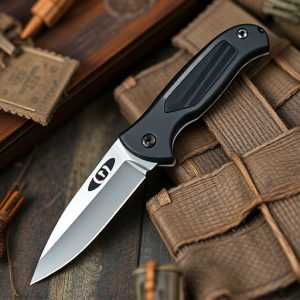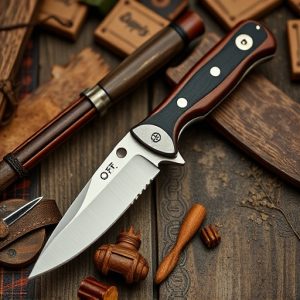Mastering the OTF Automatic Knife: Legalities, Evolution, and Maintenance
OTF (One-Time-Flyback) automatic knives represent a sophisticated blend of engineering and function…….
OTF (Out-The-Front) automatic knives represent a sophisticated blend of engineering and functionality, known for their swift deployment and robust construction from high-grade stainless steel. These tools are legally classified as switchblades under the Federal Switchblade Act of 1958, with varying state laws that dictate their ownership and use. The mechanics of an OTF knife rely on a complex system of springs, pivoting components, and ball bearings, which propel the blade into an open position at the touch of a button. For optimal performance and longevity, regular cleaning and professional servicing are essential. This maintenance includes careful cleaning of all parts, application of silicone-based lubricant, and periodic assessment and re-lubrication by professionals to ensure safety and reliability for various applications. As indispensable tools for tactical operations, outdoor survival, or daily carry, OTF automatic knives must be handled with due legal consideration, reflecting their status as both a technological marvel and a tool that requires responsible ownership.
OTF automatic knives, often abbreviated as OTF, represent a blend of precision engineering and tactical utility. This article delves into the intricacies of these devices, from their mechanics to legal standing, and everything in between. We’ll explore their evolution, how to maintain them, top models on the market, and the techniques required for safe and effective use. Additionally, we’ll examine their role in tactical scenarios, their value to collectors, and the accessories that enhance their performance. As technology advances, we’ll also look forward to what new OTF automatic knife releases promise for enthusiasts and professionals alike.
Understanding OTF Automatic Knives: The Mechanics and Functionality
Otdelnyj takticzeskij fal’anschmidt (OTF) or automatic knives are sophisticated tools that combine functionality with rapid deployment. These knives are engineered to extend or deploy from their handle into an open position swiftly, typically upon a mere half-press of a button located on the side of the handle. The mechanics behind an OTF automatic knife involve an intricate system of springs and pivoting components that ensure smooth and consistent operation. The blade, which is contained within the handle when retracted, shoots out with precision due to the compressed energy stored in the spring mechanism. This rapid extension makes OTF knives particularly useful in situations where speed and efficiency are paramount.
The functionality of an OTF automatic knife is not only rooted in its deployment mechanics but also in its design for practical use. The blades are often made from high-grade stainless steel, offering both durability and corrosion resistance. This material choice ensures that the blade can withstand various environments and tasks. Additionally, the ergonomic handle is crafted to provide a secure grip even during strenuous activities, while the ambidextrous design allows users of either hand orientation to operate the knife effectively. The balance between the handle and the extended blade is carefully calibrated to deliver optimal control for the user, making the OTF automatic knife a versatile tool for a multitude of applications, from outdoor survival to tactical operations.
Legal Considerations and Ownership of OTF Automatic Knives
OTF, or out-the-front, automatic knives represent a specialized category within the realm of tactical and everyday carry items. When considering the ownership and legal implications surrounding these devices, it’s crucial to navigate the varying state and local laws that govern their possession and use. In the United States, for instance, the Federal Switchblade Act of 1958 sets a framework for the legality of automatic knives, defining them as switchblades subject to federal regulations. However, individual states may have their own statutes that either align with or diverge from these federal guidelines. Potential owners must familiarize themselves with these laws, as possession without adherence to legal requirements can result in severe penalties.
The legality of OTF automatic knives often hinges on their intended purpose and the manner in which they are used. For collectors or professionals whose work necessitates such tools, understanding the nuances of legislation is paramount. It’s not merely a matter of complying with laws but also ensuring that one’s rights to own and carry an OTF automatic knife are protected under the jurisdiction they reside in. Prospective owners should conduct thorough research or consult legal experts to confirm compliance with all applicable laws, including any local ordinances that may be more restrictive than state or federal regulations. The responsibility lies with the owner to ensure that their possession and use of an OTF automatic knife are both legal and ethical within their community.
The Evolution of Design: Innovations in OTF Automatic Knife Engineering
The engineering behind OTF, or One-Time-Flip, automatic knives has seen significant advancements over the years, reflecting a blend of mechanical precision and user-centric design. Initially, these devices were simple in their operation, with a thumb button that extended the blade upon pressure. Over time, manufacturers introduced enhancements to improve durability and reliability, ensuring that the blades could be deployed consistently under various conditions. Innovations such as improved locking mechanisms, smoother deployment actions, and more robust materials have elevated OTF knives from novelty items to serious tools for outdoor enthusiasts and professionals alike. The integration of ball bearings and high-speed deployment mechanisms has further refined the user experience, making the OTF automatic knife a versatile and efficient cutting instrument. Today’s models showcase a culmination of these engineering feats, offering users a seamless combination of form and function that was once unimaginable in such a specialized tool. The evolution of design in OTF knives is a testament to human ingenuity and the relentless pursuit of perfection in everyday objects.
Maintenance and Care for Your OTF Automatic Knife
Maintaining an OTF (One-Time-Flyback) automatic knife requires a combination of regular cleaning and occasional professional servicing to ensure its smooth operation and longevity. The mechanical components within an OTF knife, including the internal spring, bearings, and moving parts, are particularly susceptible to wear and tear from dust, debris, and oils. To preserve the knife’s functionality, it’s crucial to disassemble it after each use and clean all external parts with a soft cloth and mild soap or dedicated cleaning solution. Dry the components thoroughly and lubricate the internal mechanisms with a high-quality, silicone-based lubricant specifically designed for such devices. This not only prolongs the lifespan of your OTF automatic knife but also ensures it operates at peak performance.
For more intensive maintenance, it’s advisable to service your OTF knife by a professional every few years or after significant use. These services typically include a complete disassembly, thorough cleaning of all internal parts, inspection for wear, and re-lubrication as necessary. This level of care is essential for the health of your knife, as it can prevent unexpected malfunctions and extend its usable lifespan. Always refer to the manufacturer’s guidelines for specific maintenance recommendations tailored to your particular OTF automatic knife model. Regular upkeep not only ensures safety but also guarantees that your OTF automatic knife remains a reliable and trustworthy tool for various tasks.


